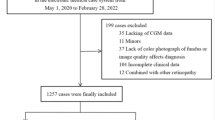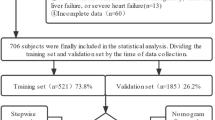Abstract
Aims
The aim of the study was to construct and validate a risk nomogram for clinically significant macular edema (CSME) prediction in diabetes mellitus (DM) patients using systemic variables.
Methods
In this retrospective study, DM inpatients who underwent routine diabetic retinopathy screening were recruited and divided into training and validation sets according to their admission date. Ninety-three demographic and systemic variables were collected. The least absolute shrinkage and selection operator was used to select the predictive variables from the training set. The selected variables were used to construct the CSME prediction nomogram. Internal and external validations were performed. The C-index, calibration curve and decision curve analysis (DCA) were reported.
Results
A total of 349 patients were divided into the training set (240, 68.77%) and the validation set (109, 31.23%). The presence of diabetic peripheral neuropathy (DPN) symptoms, uric acid, use of insulin only or not for treatment, insulin dosage, urinary protein grade and disease duration were chosen for the nomogram. The C-index of the prediction nomogram was 0.896, 0.878 and 0.837 in the training set, internal validation and external validation, respectively. The calibration curves of the nomogram showed good agreement between the predicted and actual outcomes. DCA demonstrated that the nomogram was clinically useful.
Conclusions
A nomogram with good performance for predicting CSME using systemic variables was developed. It suggested that DPN symptoms and renal function may be crucial risk factors for CSME. Moreover, this nomogram may be a convenient tool for non-ophthalmic specialists to rapidly recognize CSME in patients and to transfer them to ophthalmologists for early diagnosis and treatment.






Similar content being viewed by others

References
Cho NH, Shaw JE, Karuranga S et al (2018) IDF diabetes atlas: global estimates of diabetes prevalence for 2017 and projections for 2045. Diabetes Res Clin Pract 138:271–281
Tan GS, Cheung N, Simó R et al (2017) Diabetic macular oedema. Lancet Diabetes Endocrinol 5(2):143–155
Flaxel CJ, Adelman RA, Bailey ST et al (2020) Diabetic retinopathy preferred practice pattern®. Ophthalmology 127(1):P66-p145
Vié AL, Kodjikian L, Agard E et al (2019) Evaluation of obstructive sleep apnea syndrome as a risk factor for diabetic macular edema in patients with type II diabetes. Retina 39(2):274–280
Merante D, Menchini F, Truitt KE et al (2010) Diabetic macular edema: correlations with available diabetes therapies–evidence across a qualitative review of published literature from MEDLINE and EMBASE. Drug Saf 33(8):643–652
Das R, Kerr R, Chakravarthy U et al (2015) Dyslipidemia and diabetic macular edema: a systematic review and meta-analysis. Ophthalmology 122(9):1820–1827
Kamoi K, Takeda K, Hashimoto K et al (2013) Identifying risk factors for clinically significant diabetic macula edema in patients with type 2 diabetes mellitus. Curr Diabetes Rev 9(3):209–217
Liu E, Craig JE, Burdon K (2017) Diabetic macular oedema: clinical risk factors and emerging genetic influences. Clin Exp Optom 100(6):569–576
Milluzzo A, Maugeri A, Barchitta M et al (2021) Epigenetic mechanisms in type 2 diabetes retinopathy: a systematic review. Int J Mol Sci 22(19):10502
Balachandran VP, Gonen M, Smith JJ et al (2015) Nomograms in oncology: more than meets the eye. Lancet Oncol 16(4):e173–e180
Shi R, Niu Z, Wu B et al (2020) Nomogram for the risk of diabetic nephropathy or diabetic retinopathy among patients with type 2 diabetes mellitus based on questionnaire and biochemical indicators: a cross-sectional study. Diabetes Metab Syndr Obes 13:1215–1229
Jiang S, Fang J, Yu T et al (2020) Novel model predicts diabetic nephropathy in type 2 diabetes. Am J Nephrol 51(2):130–138
Li M, Yuan T, Li S et al (2021) Nomogram analysis of the influencing factors of diabetic foot in patients with diabetes mellitus. Hormones (Athens) 20(2):333–338
Association AD (2015) Classification and diagnosis of diabetes. Diabetes Care 38(Suppl):S8-s16
Li DY, Yin WJ, Yi YH et al (2019) Development and validation of a more accurate estimating equation for glomerular filtration rate in a Chinese population. Kidney Int 95(3):636–646
Solomon SD, Chew E, Duh EJ et al (2017) Diabetic retinopathy: a position statement by the American diabetes association. Diabetes Care 40(3):412–418
Dai P, Chang W, **n Z et al (2021) Retrospective study on the influencing factors and prediction of hospitalization expenses for chronic renal failure in china based on random forest and lasso regression. Front Public Health 9:678276
Xepapadaki E, Nikdima I, Sagiadinou EC et al (2021) HDL and type 2 diabetes: the chicken or the egg? Diabetologia 64(9):1917–1926
Zander E, Herfurth S, Bohl B et al (2000) Maculopathy in patients with diabetes mellitus type 1 and type 2: associations with risk factors. Br J Ophthalmol 84(8):871–876
Varma R, Bressler NM, Doan QV et al (2014) Prevalence of and risk factors for diabetic macular edema in the United States. JAMA Ophthalmol 132(11):1334–1340
Acan D, Calan M, Er D et al (2018) The prevalence and systemic risk factors of diabetic macular edema: a cross-sectional study from Turkey. BMC Ophthalmol 18(1):91
Mo R, Shi R, Hu Y et al (2020) Nomogram-based prediction of the risk of diabetic retinopathy: a retrospective study. J Diabetes Res 2020:7261047
Chen X, **e Q, Zhang X et al (2021) Nomogram prediction model for diabetic retinopathy development in type 2 diabetes mellitus patients: a retrospective cohort study. J Diabetes Res 2021:3825155
Bek T (2020) Systemic risk factors contribute differently to the development of proliferative diabetic retinopathy and clinically significant macular oedema. Diabetologia 63(11):2462–2470
Pradhana D, Priya MNS, Surya J et al (2021) Optical coherence tomography-based prevalence of diabetic macular edema and its associated risk factors in urban south India: a population-based study. Ophthalmic Epidemiol. https://doi.org/10.1080/09286586.2021.1907846
Moran EP, Wang Z, Chen J et al (2016) Neurovascular cross talk in diabetic retinopathy: pathophysiological roles and therapeutic implications. Am J Physiol Heart Circ Physiol 311(3):H738-749
Zhang B, Chou Y, Zhao X et al (2021) Early detection of microvascular impairments with optical coherence tomography angiography in diabetic patients without clinical retinopathy: a meta-analysis. Am J Ophthalmol 222:226–237
Salvi L, Plateroti P, Balducci S et al (2016) Abnormalities of retinal ganglion cell complex at optical coherence tomography in patients with type 2 diabetes: a sign of diabetic polyneuropathy, not retinopathy. J Diabetes Compli 30(3):469–476
Liu ZY, Ma XJ, Liao DY et al (2019) Association of urinary albumin excretion with central foveal thickness and intravitreal conbercept treatment frequency in patients with diabetic macular edema. Int J Ophthalmol 12(10):1598–1604
Yamamoto M, Fujihara K, Ishizawa M et al (2019) Overt proteinuria, moderately reduced egfr and their combination are predictive of severe diabetic retinopathy or diabetic macular edema in diabetes. Invest Ophthalmol Vis Sci 60(7):2685–2689
Lai IP, Huang WL, Yang CM et al (2020) Renal biomarkers for treatment effect of ranibizumab for diabetic macular edema. J Diabetes Res 2020:7239570
Daruich A, Matet A, Moulin A et al (2018) Mechanisms of macular edema: beyond the surface. Prog Retin Eye Res 63:20–68
Klaassen I, Van Noorden CJ, Schlingemann RO (2013) Molecular basis of the inner blood-retinal barrier and its breakdown in diabetic macular edema and other pathological conditions. Prog Retin Eye Res 34:19–48
Ciardella AP (2004) Partial resolution of diabetic macular oedema after systemic treatment with furosemide. Br J Ophthalmol 88(9):1224–1225
Krizova L, Kalousova M, Kubena AA et al (2015) Correlation of vitreous vascular endothelial growth factor and uric acid concentration using optical coherence tomography in diabetic macular edema. J Ophthalmol 2015:478509
Zhu DD, Wang YZ, Zou C et al (2018) The role of uric acid in the pathogenesis of diabetic retinopathy based on notch pathway. Biochem Biophys Res Commun 503(2):921–929
Kuwata H, Okamura S, Hayashino Y et al (2017) Serum uric acid levels are associated with increased risk of newly developed diabetic retinopathy among Japanese male patients with type 2 diabetes: A prospective cohort study (diabetes distress and care registry at Tenri [DDCRT 13]). Diabetes Metab Res Rev 33(7):e2905
Pilemann-Lyberg S, Hansen TW, Persson F et al (2019) Uric acid is not associated with diabetic nephropathy and other complications in type 1 diabetes. Nephrol Dial Transplant 34(4):659–666
Wang Y, Lin Z, Zhai G et al (2020) Prevalence of and risk factors for diabetic retinopathy and diabetic macular edema in patients with early and late onset diabetes mellitus. Ophthalmic Res. https://doi.org/10.1159/000508335
Stratton IM, Adler AI, Neil HA et al (2000) Association of glycaemia with macrovascular and microvascular complications of type 2 diabetes (UKPDS 35): prospective observational study. BMJ 321(7258):405–412
Nathan DM, Genuth S, Lachin J et al (1993) The effect of intensive treatment of diabetes on the development and progression of long-term complications in insulin-dependent diabetes mellitus. N Engl J Med 329(14):977–986
Wang PH, Lau J, Chalmers TC (1994) Metaanalysis of the effects of intensive glycemic control on late complications of type I diabetes mellitus. RETINA 14(3):287–288
Zhao C, Wang W, Xu D et al (2014) Insulin and risk of diabetic retinopathy in patients with type 2 diabetes mellitus: data from a meta-analysis of seven cohort studies. Diagn Pathol 9:130
Zhang J, Ma J, Zhou N et al (2015) Insulin use and risk of diabetic macular edema in diabetes mellitus: a systemic review and meta-analysis of observational studies. Med Sci Monit 21:929–936
**gi AM, Tankeu AT, Ateba NA et al (2017) Mechanism of worsening diabetic retinopathy with rapid lowering of blood glucose: the synergistic hypothesis. BMC Endocr Disord 17(1):63
Fei Z, Gao W, Xu X et al (2021) Serum superoxide dismutase activity: a sensitive, convenient, and economical indicator associated with the prevalence of chronic type 2 diabetic complications, especially in men. Free Radic Res 55(3):275–281
Zhao JS, ** HX, Gao JL et al (2018) serum extracellular superoxide dismutase is associated with diabetic retinopathy stage in chinese patients with type 2 diabetes mellitus. Dis Markers 2018:8721379
Acknowledgements
The research was funded by Science and Technology Projects of Guangzhou, China (3030901006062), and Project of Administration of Traditional Chinese Medicine of Guangdong Province, China (20221077).
Funding
The research was funded by Science and Technology Projects of Guangzhou, China (3030901006062) and Project of Administration of Traditional Chinese Medicine of Guangdong Province, China (20221077).
Author information
Authors and Affiliations
Corresponding authors
Ethics declarations
Conflict of interest
The authors declare that they have no conflict of interest.
Human and animal rights
All procedures followed were in accordance with the ethical standards of the responsible committee on human experimentation (institutional and national) and with the Helsinki Declaration of 1975, as revised in 2008 (5).
Informed consent
Not applicable.
Additional information
Publisher's Note
Springer Nature remains neutral with regard to jurisdictional claims in published maps and institutional affiliations.
This article belongs to the topical collection Eye Complications of Diabetes, managed by Giuseppe Querques
This article belongs to the topical collection Eye Complications of Diabetes, managed by Giuseppe Querques.
Supplementary Information
Below is the link to the electronic supplementary material.
Rights and permissions
About this article
Cite this article
Li, Z., Deng, X., Zhou, L. et al. Nomogram-based prediction of clinically significant macular edema in diabetes mellitus patients. Acta Diabetol 59, 1179–1188 (2022). https://doi.org/10.1007/s00592-022-01901-3
Received:
Accepted:
Published:
Issue Date:
DOI: https://doi.org/10.1007/s00592-022-01901-3



